
This year a lot of my work as Visiting Scholar at the David and Lucile Packard Foundation is working with grantees outside of the US. Last week, I had the pleasure of working with a group of Population and Reproductive Health grantees from Pakistan on a peer learning group called “The Networked NGO,” based on the ideas in my book, The Networked Nonprofit. The four-day intensive face-to-face training was for senior level staff and their social media staffers. It marked the start of a six month peer learning exchange where I, along with colleague Stephanie Rudat will work remotely with grantees as they implement an action learning project to put techniques into practice and facilitate organizational change from the inside out.
We are working very closely with Dr. Yasmeen Qazi who is the Pakistan Country Advisor and her very talented team members, Dr. Iftikhar Soomro and Seema Zameer — all of whom understand capacity building programs. organizational change, and technology.
This blog post includes some reflections on the instructional design, delivery, and insights that I hope will inform the field building discussion taking place over at the Packard OE Program site.
1. Program Design

When you design a capacity building project based on peer learning and is focused on topics that will require transformative organizational change to apply skills and knowledge, it is important to have a realistic and clear idea about what constitutes success. Not thinking this through at the beginning can spell disaster, especially if there are unrealistic expectations and you are working in places where connectivity is a barrier.
This project has identified the following definitions of success:
- A Peer-to-Peer Learning Exchange
Grantees will engage in peer discussions about integrating social media effectively into their communications strategies and will learn from each other – from challenges and missteps as much as from accomplishments and wins – so success means organizations sharing both.
- Networked NGOs and Social Media Integrated Into Organizational Communications
Through the 4-day workshop in-country and subsequent online and conference calls, grantee organizations will start to embrace the practices of Networked Nonprofits and begin to institutionalize social media strategies and integrate them into their broader strategy for communications on population and reproductive health or girls and girls and women’s empowerment.
- Grantees Implement A Modest and Realistic Action Learning Pilot
Social media practices are just that – they get strong and stay strong with practice – so success means consistent application and learning. With facilitator’s guidance, grantees will design and implement a small action learning project. But smart is as important as strong, so success also means deliberate integration of social media strategies with the organization’s broader communications plan and learning from doing in small steps.
- Purposeful Measurement to Inform Replication
Grantee organizations will measure what matters. Social media can be filled with metrics to track results. But not all metrics are equally valuable, and choosing the measurements that matter can be complicated. Even more importantly, the practice of connecting measurement and decision-making will help organizations improve practice and results, and document value. Success means using metrics to learn how to improve practice effectively, both to identify obstacles and track progress. The action learning project will be designed to help grantees build a habit of measurement, reflection, and organizational learning.
These definitions have informed the curriculum, instructional design, peer learning design, and how we will measure and learn along the way. The specific indicators of program success are below and were identified with input from participants:
- 100% of participants will develop an integrated and measurable social media strategy that furthers their communications work in population and reproductive health that aligned with institutional goals
- 100% of participants implement a process and write a social media policy that addresses organizational adoption issues
- 100% of participants implement an action learning project that uses measurement to help improve their practice, share insights with peers, and identify opportunities to amplify each other’s voices through social media


It is also important clarify these expectations with participants. We did this on Day 1. It followed a presentation of the program design where we facilitated an exercise and discussion about their hopes and concerns for the program. On our monthly calls, we will be measuring progress based on these indicators. I’m sure issues will emerge, but hoping to find out what works and what doesn’t and discuss openly with participants as the technical assistance and action learning projects unfold!
2. Design for Organizational Reluctance
An important design consideration is the selection of participants. For this project, participants were carefully vetted, avoiding organizations that were in a leadership transition, had other organizational priorities to address or did not have the capacity to apply the skills or knowledge. The latter includes a lack of a formal communication strategy or staffing limitations.
The program was designed for two participants per organization, a senior level staff and the staff person who implements social media. Focusing peer learning exchanges on one group or the other doesn’t go quite as a far nor can it effectively overcome reluctance and get at transformative change within the organization. In addition, as part of opting into the program, the CEO or Executive Director had to sign a letter of agreement that clearly articulated the time commitment.


The workshop lasted four days, with each day devoted to a specific theme: 1) Networked NGOs, Networks, and Change from the Inside Out 2) Integrated Social Media Strategy 3) Effective Practice and Techniques 4) Action Learning Pilots, Measurement, and Remote Support. The senior staff participated with social media staff for the first two days and then the social media worked together (without their bosses present) for two days on the practical and tactical.
During the training, I put “red” dots on the name cards of the senior staff and “yellow” dots for social media staff. Since the curriculum addressed organizational barriers head on and different scenarios about sharing control or organizational concerns, we started to talk about the different “red dot” and “yellow dot” challenges when it comes to using social media in an organization. We did a lot of role playing and scenarios as well as concrete work on developing their social media policies. In addition to the tactical and skills instruction we did with the social media staff on Day 3 and Day 4, we also covered how to manage time and work efficiently – and how to best provide support for the strategies.
Peer Synergy is also important — and for the next six months we will have two tracks for the peer groups. We will work with the “red dots” on developing the social media policy and strategy as well as working with the “yellow dots” on their action learning project. I’ve worked hard to incorporate the principles of leveraging peer learning that the Monitor has begun to codify through interviews with me and other Packard grantees and providers working on peer learning projects.
3. Dealing with Connectivity Issues, Remote Work, and Use of Social Platforms
A lot of more of my work recently has been with nonprofits in countries where Internet connectivity isn’t as robust as is in the US and where even electricity can be a problem. Over the past 20 years of providing capacity programs online, I’ve faced my share of bandwidth challenges. That’s why we will not rely solely on online channels to facilitate discussions. We will use SKYPE out which is more rebust for monthly conference calls, scheduled for business hours in Pakistan so participants can use the Internet connection at their offices. We are recording the calls so those that face electricity/connectivity problems can download it as a podcast and listen to the recordings later – and view slides/ notes.
In addition, we will be using a wiki to showcase learning and a private Facebook group for daily contact and “just in time” support. I selected the latter because all participants are on Facebook and can access it on their mobile phones. As part of the face-to-face training, we spent a day introducing participants to the different platforms and because we had wifi at the training, integrated using it as part of the exercise report outs. We are also using a Facebook group for daily communication. The Facebook daily check-ins in-between our calls are to provide support and facilitate discussion
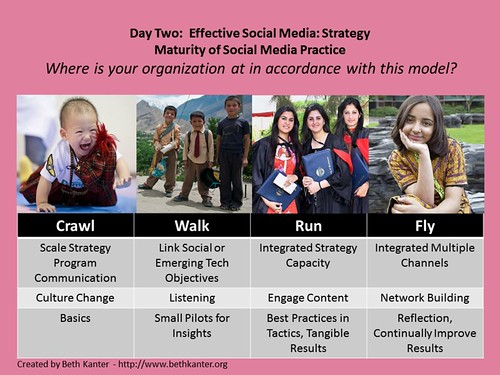
3. Create A World Fusion Curriculum
All of my workshops are customized design, so I know how to infuse the participant’s voices – whether it be their own living case studies or examples from NGOs in their country or field. I was very lucky to work with Stephanie Rudat on this project who has spent a lot of time in Pakistan training Youth Activist NGOs to use social media. Her knowledge of the country and the culture made it easier to localize the curriculum.
However, it is important to have a mix – examples from other fields and countries. If participants can see themselves in the case studies and examples, there is less resistance. If you can expose them to examples from other fields or countries, then it broadens their horizons. You need that for new ideas, innovation, and fresh thinking.
This mixture was embedded in every aspect from the instructional design – from icebreakers to reflection exercises to presentation content, examples, and frameworks.
For example, on Day 2 we covered strategy and social media integration. The curriculum includes the “Crawl, Walk, Run, Fly” framework that I developed over the past couple of years and is included in my next book. There is also an self-assessment exercise. However, to localize it, Stephanie incorporated Pakistani imagery, including a photo of Arfa Karim, the youngest female Microsoft ‘expert’ in Pakistan, to represent fly. She was very famous in her country although, sadly she recently passed away from complications of a seizure.
Also on Day 2, we shared examples of Networked NGOs from different places in the world as well as used a case study exercise focusing on NGOs in Pakistan that had used social media effectively.
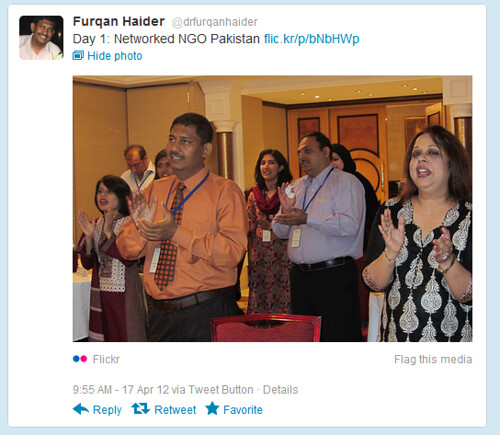
We even localized and mixed up our energizers and icebreakers. On the first day, we all sang “Dil Dil Pakistan,” a well-loved song that most people from Pakistan know.
But on Day 2, we shared a famous dance from America (The Chicken Dance) and made everyone do it after lunch so they were energized for the afternoon.
4. Design To Build A Community of Practice

Throughout the four days, there were many opportunities for peer interaction and group exercises designed to build trust, identify common points of experience and knowledge, and opportunities for reciprocity. On Day 1, since the theme was networks, we created a knowledge network of our existing knowledge and desired knowledge areas using a visual facilitation technique with sticky notes. I was impressed with range and breadth of strategy and tactical skills of people in the room. There was a lot of synergy and points of reciprocity. Having this network map on the wall during the whole training, let us as the trainers acknowledge the expertise and knowledge in the room.
That’s important because after the training is done, the participants will need to have grown in their comfort and skill levels to proceed without. My indicator of success for capacity building and training projects is that I’ve put myself out of a job.

Building on the theme of networks for Day 1, we had participants draw a network map of their networks as is suggested in the Networked Nonprofit. This exercise is very useful because after participants create their maps, they’re taped on the wall, and participants give feedback using sticky notes. Then each group presents their map as we do a walk around the room. This exercise not only leads to places where peers can share knowledge, but since it is an organizational lens – it also opens the door for ideas for networked approaches. It almost always naturally leads to discussion about how to amplify each other’s voices using social media.

What I loved about this exercise, is that after Stephanie and I modeled taking photographs and sharing on our Facebook Group or Twitter, participants started to also document digitally. We were able to thoroughly document the exercise here.
We had participants begin to work through their social media strategy, but to encourage insights about how to leverage a networked effect, we had them create SMART objectives as a gallery. Using this visual techniques, allows participants to give each other feedback and also see points of connection.
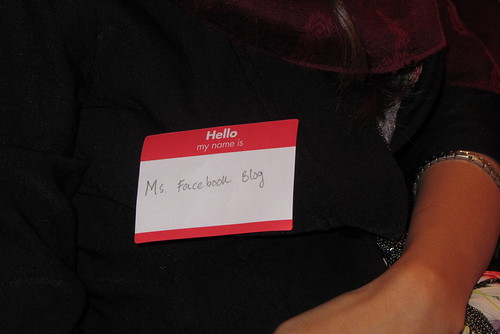

On Day 3, when it was time to focus on more time on teaching the tools, we started with an opening exercise designed to help identify those in the room who had knowledge. Participants made name badges using selecting tool names for their first and last name. They had to create name that represented a tool they already knew and one they wanted to learn more about. Then we did several rounds of speed dating which allowed for a lot of peer to peer help on using tools. One participant told me that she never learned so much about social media in so short a time. The power of peer knowledge at work!

We had wifi in the room and participants brought their laptops – this give us the opportunity for open lab time or what I call “shoulder to shoulder” learning. We spent half of Day 4 introducing participants to the various platforms we would using to keep in touch over the six months as they implemented action learning projects. For example, the wiki, where participants will keep journals, we had them do some of the exercises related to designing their project on the wiki to learn how to use it. This helped us identify participants who were already comfortable with the wiki and we put them to work teaching the others.
5. Integrate Practical Use of the Tools for Reflection, Network Weaving, Getting Ideas, Follow Up Work
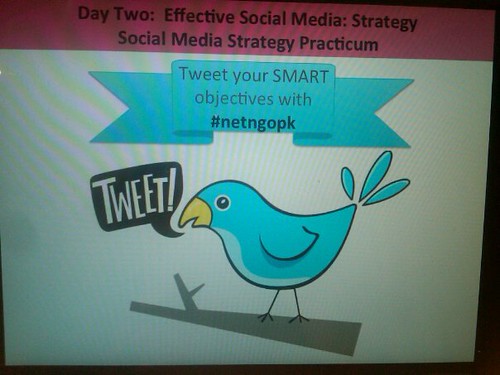
We incorporated hands-on time and shoulder to shoulder learning from Day 1. We started by introducing Twitter as a networking and professional development tool and succeeded in getting all the senior staff (red dots) tweeting by the end of Day 1. At different points in the day, we took “Twitter breaks” for reflection or networking.

And, if questions emerged about a specific case study or example we shared – we would point out that they could tweet that person and ask them the question. This happened when we shared some examples from the American Red Cross and participants tweeted their questions to Wendy Harman (who answered).

We introduce the Facebook Group on Day 2 so that both senior managers and the social media staff could add themselves. Then we incorporate the use of the Facebook for reflection exercises and to capture some of the knowledge that was shared in the room. For example, for one exercise, we had participants document their contribution to the “me to we” networked exercise.
6. Design for Reflections and Connections To Actual Work Experience
It is really important to build in plenty of time for reflection so participants can connect what they are learning in a workshop to their work experience. A workshop that simply attempts to stuff content into people’s brains is highly ineffective. The curriculum incorporated “overnight” reflections everyday as well as many exercises to help process what they learned. On Day 4, we incorporated some role playing exercises that helped participant learn about being efficient with social media or managing situations where control issues might occur. This was an area that I improvised on the spot based on what I hearing the room – and again I realized the importance of not only teaching the how-to of how the tools works, but to understand how to integrate a new way of working into your daily routine and manage time better.

7. Make It Fun, Celebrate
I believe strongly that professional learning can be fun and it can be more effective that way. We engage our learners in many different ways – from role playing, games, interactive exercises, interactive presentations, self-directed learning, drawing, teaching others, and having conversations about the topics.
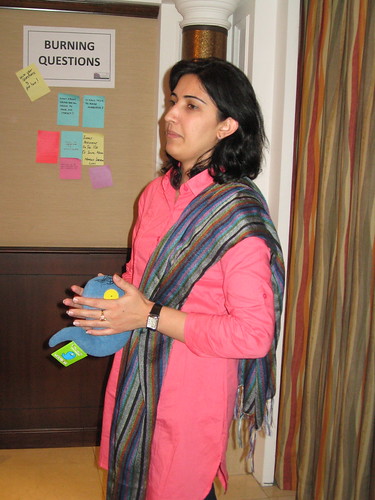
International trainings tend to be longer because participants may traveling from different locations. That’s why it is good to have different moving around exercises. One that I use when people get tired, is to have them stand in a circle and we toss a ball. But, I usually bring a “ugly” doll. It makes a game out of learning – and keeps people involved.

We also gave awards, certificates, and chocolates as well as surprise and humor to keep everyone involved.
I am looking forward to the next six months of working with this amazing group of Packard Foundation grantees half-way around the world.
What has been your experience designing capacity building programs? Discuss here
